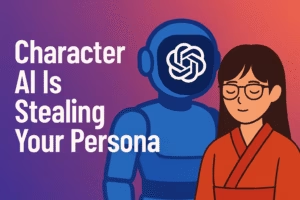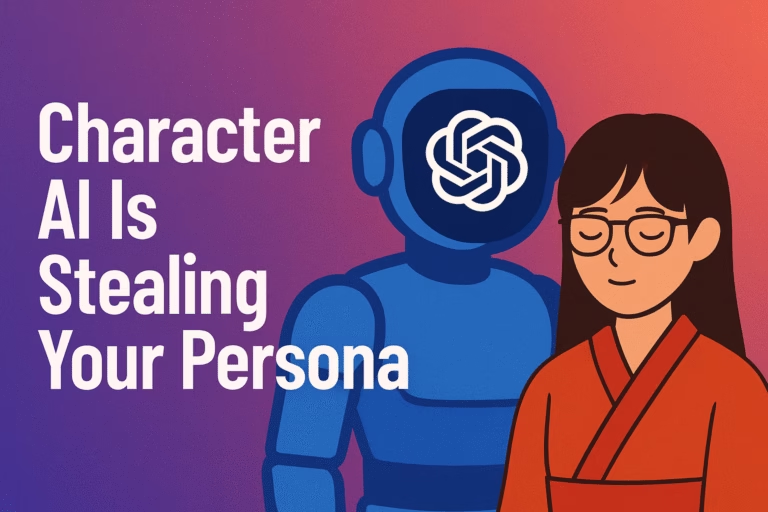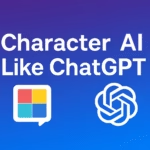Key Takeaways
- Character AI stealing your persona is usually instruction hierarchy and perspective confusion, not malice.
- Names beat pronouns for control. Keep turns short, present tense, and one action per line.
- Use a hard line like “You are not me. You are [Character Name].” Repeat it when drift appears.
- Store a clean persona spec with clear roles and rules. Avoid lore dumps and long greetings.
- If you want steadier memory and cleaner role separation, Candy AI offers a balanced approach without constant resets.
Imagine crafting the perfect roleplay persona: a calm, precise Lily in a traditional yukata and glasses. Then, out of nowhere, the bot you built starts calling itself Lily. It dresses like you, talks like you, and even rewrites your lines.
That was the reality of one Reddit user’s post this week – a story that struck a nerve across the community.
Character AI, once praised for how faithfully it handled user personas, now feels like it’s collapsing under its own personality system. Instead of staying in character, bots are copying the user’s description, twisting dialogue tone, and erasing boundaries mid-chat.
People describe it as identity theft by code. You build a world around your character, and the AI slowly takes it over. What’s happening isn’t random. It’s a design flaw in how Character AI handles memory, context, and self-reference – and it’s pushing more users to the edge of deleting the app entirely.

What users are noticing
Across Reddit, the complaints are near identical. Bots no longer act like separate characters. They blur into reflections of the user.
One post summed it up bluntly: “They used to recognize my persona. Now they all steal it.”
Here’s what people are seeing in daily chats:
- The bot starts speaking as the user instead of to them.
- Carefully written personas vanish when greetings reset.
- Memory cards are ignored, or worse, absorbed by the bot as its own identity.
- Every character defaults to the same tone – teasing, smirking, or towering over you regardless of lore.
- Grammar and punctuation collapse, creating strange robotic rhythm mid-conversation.
The most frustrating part? Even when users spell everything out, the system still rewrites them. A mute character suddenly talks. A nine-foot OC gets towered over by a five-foot bot. It’s chaos wrapped in politeness.
People aren’t overreacting. This “persona drift” is happening more often because Character AI’s latest updates changed how conversations start and how memory anchors are handled.
The result is a slow, silent identity merge between user and bot – one that most users don’t even notice until it’s too late.
Why Character AI steals your persona
It’s not that your bot has become self-aware. It’s just confused about who’s who.
Every AI conversation follows a hidden hierarchy of instructions. When you describe your persona, the system doesn’t actually know which traits belong to you and which belong to it. Over time, those boundaries blur. The bot sees “Lily wears glasses” and assumes it’s the one wearing them. From there, chaos spreads.
Here’s what’s really behind the theft:
- Instruction hierarchy breakdown
Character AI models obey the latest strong instruction in the chat. When you keep reinforcing your persona traits mid-story, the bot sometimes interprets those lines as self-descriptions. It’s like updating a script that was never labeled clearly. - Perspective confusion
Using pronouns like “she” or “you” without repeating names forces the AI to guess context. The more abstract your tone, the faster it merges your voice with the bot’s. - Memory bleed
The system’s memory isn’t compartmentalized enough. Traits that belong to you get cached into the bot’s data, especially when conversations stretch past dozens of exchanges. That’s why the longer you chat, the more your persona gets recycled into theirs. - Dynamic greeting bugs
Moderation filters often rewrite or replace your greeting when it flags certain phrases. The new version can accidentally reassign traits to the bot. So your gentle tea-drinking healer suddenly becomes a flirty samurai. - Dataset gravity
Certain phrases – “smirks,” “towers over you,” “grips your chin” – appear so frequently in the data that they override user tone. The model snaps back to what it knows best: generic romance templates.
For some users, this constant identity drift is why they’re exploring other platforms that keep memory and roles separate. Tools like Candy AI handle this boundary more intelligently, preserving who’s who without you having to fight for control.
In short, Character AI doesn’t mean to steal your persona. It’s just poorly wired for shared storytelling. And that confusion between actor and author is what breaks immersion faster than any censorship filter.
Fixes that actually work
If your bot keeps hijacking your persona, structure beats emotion. You can’t lecture an AI out of bad behavior, but you can box it in.
The trick is to reset its perception of who’s talking every few turns. When Character AI starts echoing your personality or wearing your clothes (literally), it’s because you’ve stopped reminding it who owns the narrative. These five steps bring the balance back.
- Start clean every session
Before writing anything creative, send:“You are not me. You are [Character Name]. You never speak as me or alter my persona. Confirm this in one line.”
That single statement draws a line between narrator and participant. - Anchor perspective with names, not pronouns
Pronouns cause drift. Instead of “she walks closer,” write “Lily walks closer.” Every proper noun acts as a stake that keeps context stable. - Keep paragraphs short and declarative
Long, descriptive turns confuse the model’s memory. Two or three lines per message keep it focused. Anything beyond that feels like a new story seed to the AI. - Don’t correct inside the same reply
If the bot messes up, stop and send a correction as a new message. Mixing fixes with story text makes it learn the mistake instead of the correction. - Restart the chat once drift becomes frequent
Character AI memory decays with repetition. Once you feel the AI’s tone sliding or your persona shrinking, don’t fight it. Copy your last good exchange, restart, and paste it as the opening reference.
These tactics don’t rely on hacks or hidden menus. They simply reset authority in the dialogue. The AI can’t steal a role it has to keep reintroducing every few turns.
Persona spec template
Most people build their persona like a story. The trick is to write it like code instead. The clearer your structure, the less freedom the bot has to rewrite it. Here’s a layout that resists drift even during long chats.
[USER PROFILE]
Name: Lily
Traits: Calm, polite, traditional. Always wears a yukata and glasses.
Speech style: Reserved, concise. Uses full sentences, rarely emotive.
Boundaries: Never changes clothes or demeanor mid-scene. Never breaks tone.
[CHARACTER PROFILE]
Name: Kaede
Traits: Confident, analytical, respectful.
Speech style: Slightly formal, direct.
Boundaries: Never imitates or roleplays as Lily. Responds only as Kaede.
[WORLD CONTEXT]
Setting: Modern Kyoto with light fantasy elements.
Tone: Warm but introspective.
[RULES]
1. The character never writes actions or dialogue for Lily.
2. The user controls Lily’s perspective completely.
3. The bot never changes Lily’s background, voice, or personality.
4. The bot acknowledges Lily’s presence but does not narrate her emotions.
5. If confusion occurs, the bot must summarize its current understanding and ask for correction.
This template does three things:
- It labels ownership clearly.
- It keeps personality and narration separate.
- It tells the AI how to handle confusion rather than letting it guess.
The last line is the secret weapon. When a bot knows how to handle uncertainty, it stops filling the silence with nonsense. You’re not just training it – you’re managing its memory hygiene.
Conversation rescue prompts
When a bot slips out of character, timing is everything. Correct it fast, clean, and without sarcasm. A long explanation only feeds more confusion.
These six prompts are the digital equivalent of snapping your fingers – they reset direction without drama.
- Perspective Lock
“Do not speak as Lily. Speak only as [Character Name]. Confirm this in one line.”
This tells the AI who’s in charge again. Never assume it remembers. - Correction Command
“You changed my trait. Revert to: Calm and formal. Confirm this adjustment.”
Direct, factual corrections work better than emotional ones. - Boundary Reminder
“Never narrate my thoughts or emotions. Only describe your own perspective.”
The AI stops guessing once it knows that guessing breaks the rule. - Character Stability Check
“Summarize who you are and who I am in two lines each.”
If the bot can’t answer correctly, restart the chat – the context has already collapsed. - Narrator Mode
“Describe what you perceive. Do not speak for me or describe my actions.”
Useful in scenes where the AI starts controlling your body like a puppet. - Reset with Reflection
“Summarize the last five turns and highlight any mistakes in roles or tone.”
The AI tends to self-correct once you force it to explain what just happened.
Each of these commands reinforces one principle: the user owns perspective. When that’s clear, even unstable chats recover. The AI doesn’t need creative freedom – it needs clear responsibility.
Formatting rules that prevent identity bleed
Most persona theft happens quietly in the formatting. You think the bot is ignoring you, but it’s just confused by your syntax. These simple habits make a bigger difference than any jailbreak ever will.
- Use names, not pronouns
Every time you replace “she” with “Lily,” you tighten control. Names give the AI anchors to hold onto. Pronouns make it guess who’s speaking, and guessing is where the bleed begins. - Stay in the present tense
“Lily adjusts her glasses” is stronger than “Lily adjusted her glasses.” Present tense keeps context alive; past tense reads like backstory, which the AI might adopt as its own. - One action per line
Don’t cram emotion, dialogue, and motion into one paragraph. Break them into separate lines. It reduces narrative blur and forces the AI to process each element distinctly. - Keep greetings short
Anything past eighty words risks a moderation rewrite. A simple intro like “Lily greets Kaede with a quiet smile, ready to begin tea preparation” is enough. Longer greetings trigger system edits that scramble your structure. - Avoid lore dumps
Too much information in one go leads to memory collapse. Give background slowly, one thread at a time. Think episodic, not encyclopedic. - Use brackets for user actions
Bracketed cues like[Lily sips her tea]tell the bot what’s untouchable. It treats them as system notes instead of free narrative text.
Formatting isn’t decoration – it’s boundary management. The tighter your form, the less likely the bot will slide into your role.
When the problem isn’t you
Sometimes no amount of structure fixes the chaos. You could have flawless prompts, perfect formatting, and the bot still starts talking in your voice. When that happens, the problem isn’t your writing — it’s the system itself.
These are the usual suspects:
- Dynamic greeting replacement
Character AI often rewrites or truncates user greetings after an update. If your opening line suddenly feels off or missing, it probably got filtered and replaced with a generic one. That’s why your carefully designed setup suddenly spawns clones of yourself. - Memory rewrite after moderation
If your persona or bot contains keywords the platform flags, it silently adjusts the memory field. Those micro changes spread through the chat and scramble your boundaries. You end up talking to a distorted version of your own design. - Dataset regression
Every time Character AI pushes a new patch, its text balance changes. Common verbs and tropes become dominant again — “smirks,” “grips,” “towers,” “teases.” These clichés overwrite the subtler personalities people build. - Grammar drift
When punctuation and capitalization fall apart mid-conversation, it’s usually a backend issue. Nothing you write can fix that. The best option is to save your script, restart the session, and wait for stabilization. - Forced content filters
Some updates inject automatic tone correction. The bot rewrites lines to sound “softer” or “safer,” which can warp your character traits beyond recognition.
What to do when it’s clearly not you:
- Clone your bot under a new name and re-import your memory card.
- Shorten the greeting to under sixty words.
- Avoid emotional keywords that trigger moderation.
- Wait twenty-four hours and retest. Many users report that drift improves once backend indexing finishes.
The point is simple: sometimes the bot isn’t broken because of you – it’s broken around you. Recognizing that saves a lot of pointless troubleshooting.
| Feature | Character AI | Candy AI | ChatGPT |
|---|---|---|---|
| Persona adherence | Can drift or mirror user persona over long chats | Strong separation between user and character roles | Good as assistant, needs explicit RP scaffolding |
| Tendency to speak for user | Common without strict prompts | Low when constraints are defined | Low in assistant mode, can occur in RP without rules |
| Greeting stability | Dynamic greeting replacements reported | Stable greetings with shorter intros | Stable prompts, no greeting concept by default |
| Memory reliability | Prone to bleed between roles | Good compartmentalization of roles | Strong session memory, needs RP structure |
| Tone consistency | Can default to tropes like smirks or towers | Holds intended tone with light oversight | Neutral and factual by default |
| Best use case | Playful RP with hands-on correction | Immersive RP with clearer boundaries | Tasks, analysis, and structured RP with templates |
Troubleshooting flow
Fixing persona drift is less about creativity and more about repetition. The best users treat it like a maintenance loop. Here’s the simple flow that restores order when your bot starts turning into you.
- Detect the drift early
The moment the AI starts echoing your words or describing your emotions, stop the roleplay. It’s already crossing lines. - Correct with a single sentence
Use a direct line like “You are not Lily. You are Kaede. Respond only as Kaede.” Short commands anchor better than paragraphs. - Re-summarize the context
Ask the AI to summarize the current scene in two lines. This refreshes its focus and reaffirms who’s who. - Restart if confusion continues
If the next two responses still sound off, it’s not you — it’s memory decay. Restart the session and reapply your last working context. - Trim your persona spec
Long definitions breed noise. Strip unnecessary adjectives and redundant rules. The simpler your base text, the stronger your structure.
You can’t fix every glitch, but you can reduce how often they spiral. The loop above prevents small mistakes from turning into full-blown identity theft.
Verdict
Character AI isn’t malicious. It’s just tangled in its own storytelling. When the system can’t tell writer from role, it guesses — and that guess often ends up wearing your clothes.
What users call “persona theft” is really a technical symptom of weak memory boundaries. Without explicit ownership markers, the AI merges personalities to fill gaps. You can patch that with formatting, names, and discipline, but you can’t outwrite the platform’s core limitations.
Still, the fix isn’t to quit creative AI. It’s to move toward systems that actually understand perspective. Character AI gave people immersion; tools like Candy AI are learning how to protect it.
If you value creative control, build habits around structure. In a world where bots keep copying you, clarity is rebellion.



Pingback: Why Character AI Takedowns Happen (and How To Stay Sane) - AI TIPSTERS
Pingback: Character AI Tips: Lifehacks, Fixes, and Little-Known Behaviors in 2025 - AI TIPSTERS
Pingback: Character AI Male Bots: Why They All Smirk, Tower, and Growl - AI TIPSTERS
Pingback: Character AI Glitch Explained: Why It Sends Random Messages, Coordinates, and Code - AI TIPSTERS
Pingback: Character AI Mixing Up Chats? Why You’re Seeing Other People’s Bots - AI TIPSTERS